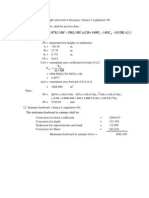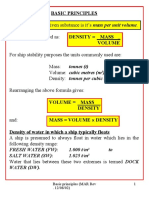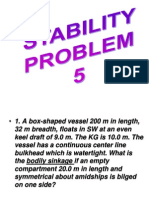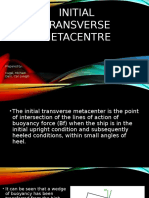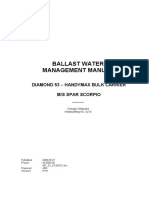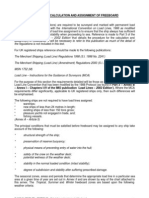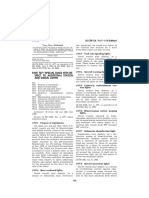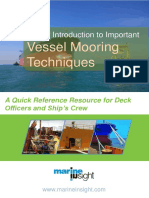RINA - Trim & Stability Booklet
RINA - Trim & Stability Booklet
Uploaded by
kevin kurnia marpaungCopyright:
Available Formats
RINA - Trim & Stability Booklet
RINA - Trim & Stability Booklet
Uploaded by
kevin kurnia marpaungOriginal Description:
Copyright
Available Formats
Share this document
Did you find this document useful?
Is this content inappropriate?
Copyright:
Available Formats
RINA - Trim & Stability Booklet
RINA - Trim & Stability Booklet
Uploaded by
kevin kurnia marpaungCopyright:
Available Formats
Pt B, Ch 3, App 2
APPENDIX 2
1
1.1
TRIM AND STABILITY BOOKLET
Trim and stability booklet
Information to be included in the trim
and stability booklet
1.1.1 General
A trim and stability booklet is a stability manual, to be
approved by the Society, which is to contain sufficient information to enable the Master to operate the ship in compliance with the applicable requirements contained in the
Rules.
The format of the stability booklet and the information
included vary depending on the ship type and operation.
1.1.2 List of information (1/10/2005)
The following information is to be included in the trim and
stability booklet:
a general description of the ship, including:
- the ships name and the Society classification
number
- the ship type and service notation
- the class notations
- the yard, the hull number and the year of delivery
- the Flag, the port of registry, the international call
sign and the IMO number
- the moulded dimensions
- the draught corresponding to the assigned summer
load line, the draught corresponding to the assigned
summer timber load line and the draught corresponding to the tropical load line, if applicable
- the displacement corresponding to the above-mentioned draughts
clear instructions on the use of the booklet
general arrangement and capacity plans indicating the
assigned use of compartments and spaces (cargo, passenger, stores, accommodation, etc.)
a sketch indicating the position of the draught marks
referred to the ships perpendiculars
hydrostatic curves or tables corresponding to the design
trim, and, if significant trim angles are foreseen during
the normal operation of the ship, curves or tables corresponding to such range of trim are to be introduced. A
clear reference relevant to the sea density, in t/m3, is to
be included as well as the draught measure (from keel
or underkeel).
cross curves (or tables) of stability calculated on a free
trimming basis, for the ranges of displacement and trim
anticipated in normal operating conditions, with indication of the volumes which have been considered in the
computation of these curves
tank sounding tables or curves showing capacities, centres of gravity, and free surface data for each tank
60
lightship data from the inclining test, as indicated in
Sec 1, [2.2], including lightship displacement, centre of
gravity co-ordinates, place and date of the inclining test,
as well as the Society approval details specified in the
inclining test report. It is suggested that a copy of the
approved test report be included.
Where the above-mentioned information is derived
from a sister ship, the reference to this sister ship is to be
clearly indicated, and a copy of the approved inclining
test report relevant to this sister ship is to be included.
standard loading conditions as indicated in [1.2] and
examples for developing other acceptable loading conditions using the information contained in the booklet
intact stability results (total displacement and its centre
of gravity co-ordinates, draughts at perpendiculars, GM,
GM corrected for free surfaces effect, GZ values and
curve, criteria as indicated in Sec 2, [2] and Sec 2, [3]
as well as possible additional criteria specified in Part E
when applicable, reporting a comparison between the
actual and the required values) are to be available for
each of the above-mentioned operating conditions. The
method and assumptions to be followed in the stability
curve calculation are specified in [1.3]
information on loading restrictions (maximum allowable load on double bottom, maximum specific gravity
allowed in liquid cargo tanks, maximum filling level or
percentage in liquid cargo tanks) when applicable
information about openings (location, tightness, means
of closure), pipes or other progressive flooding sources
any other necessary guidance for the safe operation of
the ship
a table of contents and index for each booklet.
1.2
1.2.1
Loading conditions
General
The standard loading conditions to be included in the trim
and stability booklet are:
lightship condition
ship in ballast in the departure condition, without cargo
but with full stores and fuel
ship in ballast in the arrival condition, without cargo
and with 10% stores and fuel remaining.
Additional loading conditions are required depending on
the ship type and kind of cargo carried as specified in the
following paragraphs, such loading cases being considered
as a minimum requirement. Therefore, further loading cases
may be included when deemed necessary or useful.
When a tropical freeboard is to be assigned to the ship, the
corresponding loading conditions are also to be included.
RINA Rules 2009
Pt B, Ch 3, App 2
1.2.2
Ships carrying cargo on deck
In addition to the loading conditions indicated in [1.2.1] to
[1.2.13], in the case of cargo carried on deck the following
cases are to be considered:
ship in the fully loaded departure condition having
cargo homogeneously distributed in the holds and a
cargo specified in extension and weight on deck, with
full stores and fuel
same loading condition as above, but with 10% stores
and consumables
lightship condition with full stores and consumables
lightship condition with 10% stores and consumables.
The two latter conditions are to be included for information
to the Master regarding the ships stability before loading
commences or unloading terminates.
ship in the fully loaded arrival condition having cargo
homogeneously distributed in holds and a cargo specified in extension and weight on deck, with 10% stores
and fuel.
The vertical location of the centre of gravity for each container is generally to be taken at one half of the container
height. Different locations of the vertical centre of gravity
may be accepted in specific cases, only if adequately documented.
1.2.3
1.2.5
General cargo ships
In addition to the standard loading conditions reported in
[1.2.1], at least the following loading cases are to be
included in the trim and stability booklet:
ship in the fully loaded departure condition, with cargo
homogeneously distributed throughout all cargo spaces
and with full stores and fuel
ship in the fully loaded arrival condition with cargo
homogeneously distributed throughout all cargo spaces
and with 10% stores and fuel remaining.
For ships with service notation general cargo ship completed by the additional feature nonhomload, at least the
following loading cases are also to be included in the trim
and stability booklet:
ship in the departure condition, with cargo in alternate
holds, for at least three stowage factors, one of which is
relevant to the summer load waterline and with full
stores and consumables.
Where the condition with cargo in alternate holds relevant to the summer load waterline leads to local loads
on the double bottom greater than those allowed by the
Society, it is to be replaced by the one in which each
hold is filled in order to reach the maximum load
allowed on the double bottom; in no loading case is
such value to be exceeded
same conditions as above, but with 10% stores and consumables.
1.2.4
Container ships
In addition to the standard loading conditions specified in
[1.2.1], for ships with the service notation container ship at
least the following loading cases are to be included in the
trim and stability booklet:
ship with the maximum number of containers on board
having a homogeneous weight corresponding to the
summer load waterline when loaded with full stores and
consumables
same loading condition as above, but with 10% stores
and consumables
ship with a number of containers having a weight corresponding to the maximum permissible weight for each
container at the summer load waterline when loaded
with full stores and consumables
RINA Rules 2009
Bulk carriers, ore carriers and combination
carriers
Dry cargo is intended to mean grain, as well as any other
type of solid bulk cargo.
The term grain covers wheat, maize (corn), oats, rye, barley,
rice, pulses, seeds and processed forms thereof, whose
behaviour is similar to that of grain in its natural state.
The term solid bulk cargo covers any material, other than
liquid or gas, consisting of a combination of particles, granules or any larger pieces of material, generally uniform in
composition, which is loaded directly into the cargo spaces
of a ship without any intermediate form of containment.
In addition to the standard loading conditions defined in
[1.2.1], for ships with the service notation bulk carrier ESP,
ore carrier ESP and combination carrier ESP at least the following loading cases are to be included in the trim and stability booklet:
ship in the fully loaded departure conditions at the summer load waterline, with cargo homogeneously distributed throughout all cargo holds and with full stores and
consumables, for at least three specific gravities, one of
which is relevant to the complete filling of all cargo
holds
same conditions as above, but with 10% stores and consumables
ship in the departure condition, with cargo holds not
entirely filled, for at least three stowage factors, one of
which is relevant to the summer load waterline and with
full stores and consumables
same conditions as above, but with 10% stores and consumables.
For ships with one of the service notations ore carrier ESP
and combination carrier ESP and for ships with the service
notation bulk carrier ESP completed by the additional feature nonhomload, at least the following loading cases are
also to be included in the trim and stability booklet:
ship in the departure conditions, with cargo in alternate
holds, for at least three stowage factors, one of which is
relevant to the summer load waterline, and with full
stores and consumables.
Where the condition with cargo in alternate holds relevant to the summer load waterline leads to local loads
on the double bottom greater than those allowed by the
Society, it is to be replaced by the one in which each
hold is filled in order to reach the maximum load
61
Pt B, Ch 3, App 2
allowed on the double bottom; in no loading case is
such value to be exceeded.
same loading condition as above, but with 10% stores
and consumables
same conditions as above, but with 10% stores and consumables.
three loading conditions corresponding to different specific gravities with cargo homogeneously distributed
throughout all cargo tanks and with full stores and consumables
1.2.6
Oil tankers and FLS tankers (1/10/2005)
All the intended cargo loading conditions are to be
included in the trim and stability booklet for examination
within the scope of Pt E, Ch 7, Sec 3, [1].
In addition to the standard loading conditions specified in
[1.2.1], for ships with the service notation oil tanker ESP or
FLS tanker at least the following loading cases are to be
included in the trim and stability booklet:
ship in the fully loaded departure condition at the summer load waterline, with cargo homogeneously distributed throughout all cargo tanks and with full stores and
consumables
same condition as above, but with 10% stores and consumables
ship in the departure condition loaded with a cargo having a density in order to fill all cargo tanks, with full
stores and consumables, but immersed at a draught less
than the summer load waterline
same condition as above, but with 10% stores and consumables
ship in the fully loaded departure condition at the summer load waterline, with cargo tanks not entirely filled
and with full stores and consumables
same condition as above, but with 10% stores and consumables
two loading conditions corresponding to different cargo
segregations in order to have slack tanks with full stores
and consumables.
When it is impossible to have segregations, these conditions are to be replaced by loading conditions with the
same specific gravity and with slack cargo tanks.
same loading condition as above, but with 10% stores
and consumables
For oil tankers having segregated ballast tanks as defined
in Pt E, Ch 7, Sec 1, [1.3.13], the lightship condition
with segregated ballast only is also to be included in the
trim and stability booklet for examination.
1.2.7
Chemical tankers (1/10/2005)
same loading conditions as above, but with 10% stores
and consumables
four loading conditions corresponding to different cargo
segregations in order to have slack tanks with full stores
and consumables. Cargo segregation is intended to
mean loading conditions with liquids of different specific gravities.
When it is impossible to have segregations, these conditions are to be replaced by loading conditions corresponding to different specific gravities with slack cargo
tanks.
same loading conditions as above, but with 10% stores
and consumables.
When it is impossible to have segregations, these conditions may be replaced by cases corresponding to different specific gravities with slack cargo tanks.
Possible limitations in the filling of cargo tanks due to structural matters (i.e sloshing) are to be taken into account and
are to be clearly indicated in the booklet.
1.2.8
Liquefied gas carriers (1/10/2005)
All the intended cargo loading conditions are to be
included in the trim and stability booklet for examination
within the scope of Pt F, Ch 12, Sec 11, [3.6.3].
In addition to the standard loading conditions defined in
[1.2.1], for ships with the service notation liquefied gas carrier at least the following loading cases are to be included
in the trim and stability booklet:
ship in the fully loaded departure condition, with cargo
homogeneously distributed throughout all cargo spaces
and with full stores and fuel
ship in the fully loaded arrival condition with cargo
homogeneously distributed throughout all cargo spaces
and with 10% stores and fuel remaining.
1.2.9
Passenger ships
In addition to the standard loading conditions specified in
[1.2.1], for ships with the service notation passenger ship at
least the following loading cases are to be included in the
trim and stability booklet:
All the intended cargo loading conditions are to be
included in the trim and stability booklet for examination
within the scope of Pt F, Ch 12, Sec 11, [3.5.6].
ship in the fully loaded departure condition with full
stores and fuel and with the full number of passengers
with their luggage
In addition to the standard loading conditions defined in
[1.2.1], for ships with the service notation chemical tanker
ESP at least the following loading cases are to be included
in the trim and stability booklet:
ship in the fully loaded arrival condition, with the full
number of passengers and their luggage but with only
10% stores and fuel remaining
ship in the fully loaded departure condition, with cargo
homogeneously distributed throughout all cargo tanks
and with full stores and consumables
62
ship without cargo, but with full stores and fuel and the
full number of passengers and their luggage
ship in the same condition as above, but with only 10%
stores and fuel remaining.
RINA Rules 2009
Pt B, Ch 3, App 2
1.2.10 Dredgers (1/7/2006)
For ships with one of the service notations dredger, hopper
dredger, hopper unit, split hopper dredger and split hopper unit, the following loading conditions are to be considered:
least the following loading cases are to be included in the
trim and stability booklet:
departure conditions for the fishing grounds with full
fuel stores, ice, fishing gear, etc.
departure from the fishing grounds with full catch
a) Dredging unit in lightship condition
arrival at home port with 10% stores, fuel, etc. remaining and full catch
b) Dredging unit in ballast in the departure condition without dredged materials and with the dredging devices
suitably lashed, with full stores and fuel
c) Dredging unit in ballast in the arrival condition, without
dredged materials and with the dredging devices suitably lashed, with 10% stores and fuel remaining
d) Dredging unit in working condition with full stores and
fuel, wells with homogeneous full loading of dredged
spoil up to the overflow pipes or, where the latter are
not fitted, up to the top of the hatchway and with
draught corresponding to the summer freeboard
e) Dredging unit as per item d) but with only 10% of stores
and fuel
f)
Dredging unit in working condition with full stores and
fuel, with wells with homogeneous partial loading of
dredged spoil having mass density equal to 2,2 t/m3 and
with draught corresponding to the summer freeboard
g) Dredging unit as per item f) but with only 10% of stores
and fuel.
1.2.11 Tugs and fire-fighting ships
In addition to the standard loading conditions defined in
[1.2.1], for ships with one of the service notations tug and
fire fighting ship at least the following loading cases are to
be included in the trim and stability booklet:
ship in the departure condition at the waterline corresponding to the maximum assigned immersion, with full
stores, provisions and consumables
same conditions as above, but with 10% stores and consumables.
1.2.12 Supply vessels
In addition to the standard loading conditions specified in
[1.2.1], for ships with the service notation supply vessel at
least the following loading cases are to be included in the
trim and stability booklet:
ship in the fully loaded departure condition having
under deck cargo, if any, and cargo specified by position and weight on deck, with full stores and fuel, corresponding to the worst service condition in which all the
relevant stability criteria are met
ship in the fully loaded arrival condition with cargo as
specified above, but with 10 per cent stores and fuel.
1.2.13 Fishing vessels
In addition to the standard loading conditions defined in
[1.2.1], for ships with the service notation fishing vessel at
RINA Rules 2009
arrival at home port with 10% stores, fuel, etc. and a
minimum catch, which is normally to be 20% of the full
catch but may be up to 40% provided the Society is satisfied that operating patterns justify such a value.
1.3
Stability curve calculation
1.3.1 General
Hydrostatic and stability curves are normally prepared on a
designed trim basis. However, where the operating trim or
the form and arrangement of the ship are such that change
in trim has an appreciable effect on righting arms, such
change in trim is to be taken into account.
The calculations are to take into account the volume to the
upper surface of the deck sheathing.
1.3.2
Superstructures, deckhouses, etc. which may
be taken into account (1/7/2003)
Enclosed superstructures complying with Ch 1, Sec 2,
[3.10] may be taken into account.
The second tier of similarly enclosed superstructures may
also be taken into account, except for ships of length less
than 20 m, for which only the first tier of enclosed superstructures may be taken into account and, in the event of
doors on both sides of a deckhouse, access from the top is
not required.
Deckhouses on the freeboard deck may be taken into
account, provided that they comply with the conditions for
enclosed superstructures laid down in Ch 1, Sec 2, [3.12].
Where deckhouses comply with the above conditions,
except that no additional exit is provided to a deck above,
such deckhouses are not to be taken into account; however,
any deck openings inside such deckhouses are to be considered as closed even where no means of closure are provided.
Deckhouses, the doors of which do not comply with the
requirements of Ch 9, Sec 4, [1.5.4], are not to be taken
into account; however, any deck openings inside the deckhouse are regarded as closed where their means of closure
comply with the requirements of Ch 9, Sec 7, [7.3].
Deckhouses on decks above the freeboard deck are not to
be taken into account, but openings within them may be
regarded as closed.
Superstructures and deckhouses not regarded as enclosed
may, however, be taken into account in stability calculations
up to the angle at which their openings are flooded (at this
angle, the static stability curve is to show one or more steps,
and in subsequent computations the flooded space are to
be considered non-existent).
Trunks may be taken into account. Hatchways may also be
taken into account having regard to the effectiveness of
their closures.
63
Pt B, Ch 3, App 2
1.3.3 Angle of flooding
In cases where the ship would sink due to flooding through
any openings, the stability curve is to be cut short at the corresponding angle of flooding and the ship is to be considered to have entirely lost its stability.
Small openings such as those for passing wires or chains,
tackle and anchors, and also holes of scuppers, discharge
64
and sanitary pipes are not to be considered as open if they
submerge at an angle of inclination more than 30. If they
submerge at an angle of 30 or less, these openings are to
be assumed open if the Society considers this to be a source
of significant progressive flooding; therefore such openings
are to be considered on a case by case basis.
RINA Rules 2009
You might also like
- A Ladybird Book About Donald Trump Jason Hazeley All Chapters Instant Download100% (2)A Ladybird Book About Donald Trump Jason Hazeley All Chapters Instant Download55 pages
- 4 - Hydrostatic Particulars (Stability Book)100% (1)4 - Hydrostatic Particulars (Stability Book)22 pages
- Section 23 Intact and Damage Stability: I - Part 6 GL 2010 Page 23-1No ratings yetSection 23 Intact and Damage Stability: I - Part 6 GL 2010 Page 23-18 pages
- Damage Stability Assessment of ContainershipNo ratings yetDamage Stability Assessment of Containership18 pages
- Model Questions-BSc NS-Ship Stability IIINo ratings yetModel Questions-BSc NS-Ship Stability III10 pages
- f0lc 35 Ship Stability - Theory App - Outcome 3 - Cover Sections 1-3100% (1)f0lc 35 Ship Stability - Theory App - Outcome 3 - Cover Sections 1-333 pages
- Intact Damage Stability Booklet Preliminary100% (1)Intact Damage Stability Booklet Preliminary241 pages
- Review of Practical Aspects of Shallow Water EffectsNo ratings yetReview of Practical Aspects of Shallow Water Effects11 pages
- Tanker Disasters: IMO's Places of Refuge and the Special Compensation Clause; Erika, Prestige, Castor and 65 CasualtiesFrom EverandTanker Disasters: IMO's Places of Refuge and the Special Compensation Clause; Erika, Prestige, Castor and 65 CasualtiesNo ratings yet
- Section 5 Longitudinal Strength: I - Part 1 GL 2011 Page 5-1No ratings yetSection 5 Longitudinal Strength: I - Part 1 GL 2011 Page 5-119 pages
- Excellent Notes For Intact and Damage Stability100% (5)Excellent Notes For Intact and Damage Stability15 pages
- Problem (Main Particulars.) : Freeboard Calculation Above 100m in LengthNo ratings yetProblem (Main Particulars.) : Freeboard Calculation Above 100m in Length10 pages
- Tow - Site Checklist: Rig Route: CommentsNo ratings yetTow - Site Checklist: Rig Route: Comments3 pages
- ClassNK Register of Ships - M - S EVER GRANDEUR (CNo.040308)No ratings yetClassNK Register of Ships - M - S EVER GRANDEUR (CNo.040308)2 pages
- International Convention On Tonnage Measurement of Ships, 1969100% (1)International Convention On Tonnage Measurement of Ships, 196917 pages
- Vipin Kumar Aman Malhotra Rahul Yadav Rajneesh Kumar Ishant SinghNo ratings yetVipin Kumar Aman Malhotra Rahul Yadav Rajneesh Kumar Ishant Singh4 pages
- L-Type - Anchor Handling Tug Supply VesselNo ratings yetL-Type - Anchor Handling Tug Supply Vessel8 pages
- Blank Vessel Safety Inspection Report - NPO Function100% (2)Blank Vessel Safety Inspection Report - NPO Function13 pages
- Section 4.1 - Safety: Navigation and Operations Workbook Guided LearningNo ratings yetSection 4.1 - Safety: Navigation and Operations Workbook Guided Learning6 pages
- PANAMA CANAL AUTHORITY ACP Maritime OperNo ratings yetPANAMA CANAL AUTHORITY ACP Maritime Oper70 pages
- M047 MARO K - Outstanding Works - Chengxi130623No ratings yetM047 MARO K - Outstanding Works - Chengxi1306234 pages
- A Ladybird Book About Donald Trump Jason Hazeley All Chapters Instant DownloadA Ladybird Book About Donald Trump Jason Hazeley All Chapters Instant Download
- Section 23 Intact and Damage Stability: I - Part 6 GL 2010 Page 23-1Section 23 Intact and Damage Stability: I - Part 6 GL 2010 Page 23-1
- f0lc 35 Ship Stability - Theory App - Outcome 3 - Cover Sections 1-3f0lc 35 Ship Stability - Theory App - Outcome 3 - Cover Sections 1-3
- Review of Practical Aspects of Shallow Water EffectsReview of Practical Aspects of Shallow Water Effects
- Tanker Disasters: IMO's Places of Refuge and the Special Compensation Clause; Erika, Prestige, Castor and 65 CasualtiesFrom EverandTanker Disasters: IMO's Places of Refuge and the Special Compensation Clause; Erika, Prestige, Castor and 65 Casualties
- Section 5 Longitudinal Strength: I - Part 1 GL 2011 Page 5-1Section 5 Longitudinal Strength: I - Part 1 GL 2011 Page 5-1
- Problem (Main Particulars.) : Freeboard Calculation Above 100m in LengthProblem (Main Particulars.) : Freeboard Calculation Above 100m in Length
- ClassNK Register of Ships - M - S EVER GRANDEUR (CNo.040308)ClassNK Register of Ships - M - S EVER GRANDEUR (CNo.040308)
- International Convention On Tonnage Measurement of Ships, 1969International Convention On Tonnage Measurement of Ships, 1969
- Vipin Kumar Aman Malhotra Rahul Yadav Rajneesh Kumar Ishant SinghVipin Kumar Aman Malhotra Rahul Yadav Rajneesh Kumar Ishant Singh
- Blank Vessel Safety Inspection Report - NPO FunctionBlank Vessel Safety Inspection Report - NPO Function
- Section 4.1 - Safety: Navigation and Operations Workbook Guided LearningSection 4.1 - Safety: Navigation and Operations Workbook Guided Learning




